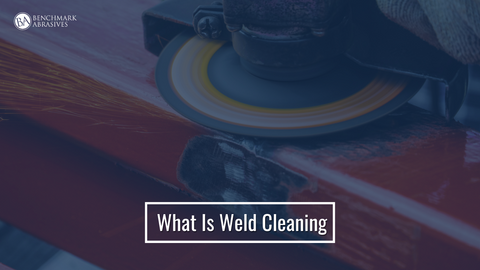
What Is Weld Cleaning

Manual welding cleaning seems to be the least expensive and most practical method, but it's far from the most efficient. Electrical current and electrolytic fluids are employed in the manufacturing sector electrochemical weld cleaning procedure. This eliminates post-heat contaminants such as heat tint, discoloration, and surface rust.
Electrolytic weld cleaning is frequently used to eliminate heat tint and discoloration and prevent corrosion in stainless steel welded joints. In the subsequent post, we'll examine electrolytic weld cleaning in more detail and contrast it with other cleaning procedures.
WHY IS WELD CLEANING REQUIRED?
Cleaning the welded region after TIG, MIG, and other welding procedures are employed is crucial to extending a welded connection's lifespan and corrosion resistance. Rust and cross-contamination are two of the most typical problems welding brings.
Cosmetic difficulties can also include other problems, including discoloration and heat tinting. Many of these problems can be resolved with electrolytic welding cleaning.
WHAT ARE A FEW REASONS WHY METALS CORRODE?
When metal joints are prepared for welding, metal is exposed to various atmospheric conditions, such as heat and humidity. This increases the possibility of rust forming. Before welding, the metal's protective passivation layer is removed by grinding, sanding, and cutting before welding.
This is why stainless steel electrolytic welding is so crucial. It helps maintain the material's strength and improves the welded joint's durability and overall appearance.
DIFFERENT WELD CLEANING TECHNIQUES?
Three methods of cleaning welds are available: mechanical, chemical, and electrolytic. In this section, we'll examine each of the three possibilities in more detail and discuss some of their benefits and drawbacks.
1. MECHANICAL WELD CLEANING
Mechanical weld cleaning procedures use abrasives like power brushes and sandpaper and instruments like grinders and sanders. It takes a lot of effort and rarely results in a beautiful or valuable finish. This method often results in surface damage.
2. CHEMICAL WELD CLEANING
Pickling paste is the most commonly used chemical weld cleaning product. Although relatively successful, chemical cleaning is declining in popularity and has numerous significant disadvantages, such as:
- HEALTH RISKS - Pickling paste contains acids, including hydrofluoric acid, nitric acid, and sulfuric acid. These acids can be deadly, especially when combined.
- EASY OF USE - Pickling paste shouldn't be used by beginners since it requires special training, procedures, and personal protective equipment
- ENVIRONMENTAL EFFECTS - Pickling paste use carries risks beyond those affecting people's health. Environmental effects, including water and air pollution, also require careful thought.
3. ELECTROLYTIC WELD CLEANING
Electrolytic weld cleaning for stainless steel and other metals is rapidly expanding globally. This is despite being one of the newest cleaning techniques. Many skilled welders believe it to be the most practical and efficient method for cleaning welded connections and one of the fastest. In the next part, we'll review the procedure and how it's applied to cleaning welded materials in the manufacturing sector.
WHAT IS THE PROCEDURE FOR CLEANING ELECTROLYTIC WELDS?
Electrolytic weld cleaning is straightforward, quick, and efficient. A conductive weld cleaning brush applies a moderate electrolytic cleaning solution to the metal surface or welded seam. Electric current speeds up the cleaning and passivation process, and electric current is applied.
The following are some advantages of using this brushing technique:
- ON-SITE RESOURCES - The brushing procedure enables the process to be carried out on-site for an immediate low-risk result rather than transporting your freshly finished work to another facility for cleaning or polishing.
- INCREASED ADAPTABILITY - No matter how and where it is used, brush setup portability enables increased versatility. There are solutions for more considerable electrolytic weld cleaning. However, they need substantial baths and a solid current supply, making them unsuitable in the field or on-site.
- SINGLE-STEP PROCEDURE - After pickling is finished, when using pickling paste, a different passivation technique is necessary. But with the brush system, passivation happens immediately; a subsequent step is not required. Removing etching from pickling paste or scratching from mechanical cleaning does not require a third refinishing stage.
- SURFACE MODIFICATION - When immersing portions or pieces in a bath, you must treat the complete component. A brush application allows for more exact and targeted treatment because you can pick and choose which sections of the metal to treat.
- AFFORDABILITY - The expense of manually cleaning electrolytic welds upfront and over time is relatively low. Large baths, however, require a substantial initial investment, either in the equipment itself or in setup expenses. This makes them unaffordable for many small- to medium-sized firms.
CONCLUSION
A post-welding procedure used to stop corrosion on metal surfaces is welding cleaning.
There are three distinct welding cleaning techniques:
- Mechanical (using abrasives to grind).
- Chemical (treatment with pickling paste).
- Electrochemical (using electrolytic fluids to clean).
The mechanical procedure takes a long time and is not very efficient. Although pickling is more efficient, it poses a severe risk to people's health.
These techniques can be quickly and safely replaced by electrochemical cleaning. Additionally, it offers higher resistance to rust and corrosion. The method works exceptionally well on stainless steel welds. Impurities like rust and others are easily eliminated or avoided.



































































